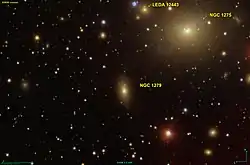NGC 1279
NGC 1279 is a lenticular galaxy estimated to be 324 million light-years away from the Milky Way[3] in the constellation Perseus.[4] It has diameter of about 110,000 ly,[3] and is a member of the Perseus Cluster.[5][6]
| NGC 1279 | |
|---|---|
 SDSS image of NGC 1279. | |
| Observation data (J2000 epoch) | |
| Constellation | Perseus |
| Right ascension | 3h 19m 59.1s[1] |
| Declination | 41° 28′ 46″[1] |
| Redshift | 0.024300[1] |
| Helio radial velocity | 7285 km/s |
| Distance | 317 Mly (97.1 Mpc)[1] |
| Group or cluster | Perseus Cluster |
| Apparent magnitude (V) | 15.5[1] |
| Characteristics | |
| Type | S/S0?[1] |
| Size | ~113,400 ly (34.77 kpc) (estimated)[1] |
| Apparent size (V) | 0.587 x 0.329[2] |
| Other designations | |
| PGC 12448, PGC 12449, 2MASX J03195907+4128462[1] | |
It was discovered on December 12, 1876 by astronomer John Louis Emil Dreyer.[6]
References
- "NASA/IPAC Extragalactic Database". Results for NGC 1279. Retrieved 2018-07-02.
- "NGC 1279". SIMBAD. Centre de données astronomiques de Strasbourg. Retrieved 2018-07-02.
- "Your NED Search Results". ned.ipac.caltech.edu. Retrieved 2018-07-02.
- "Revised NGC Data for NGC 1279". spider.seds.org. Retrieved 2018-07-02.
- Brunzendorf, J.; Meusinger, H. (October 1, 1999). "The galaxy cluster Abell 426 (Perseus). A catalogue of 660 galaxy positions, isophotal magnitudes and morphological types". Astronomy and Astrophysics Supplement Series. 139 (1): 141–161. Bibcode:1999A&AS..139..141B. doi:10.1051/aas:1999111. ISSN 0365-0138.
- "New General Catalog Objects: NGC 1250 - 1299".
This article is issued from Wikipedia. The text is licensed under Creative Commons - Attribution - Sharealike. Additional terms may apply for the media files.
